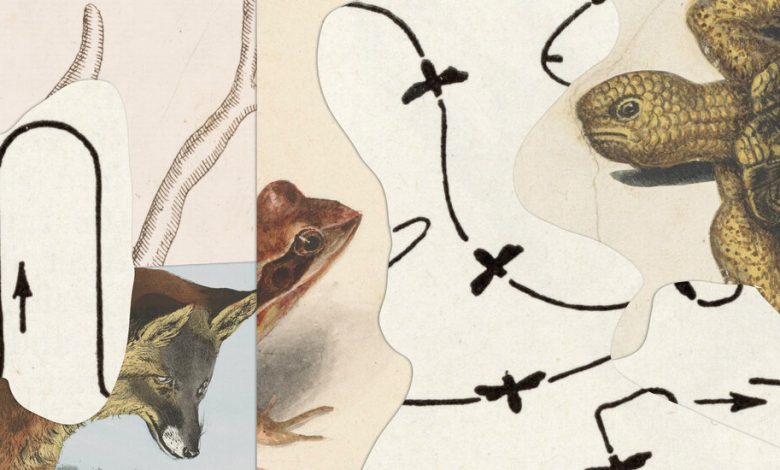Animal Magnetism — and Optimism

In a recent essay, the writer and environmental activist Terry Tempest Williams, reflecting on the perils of climate change, wrote, “Before we can save this world we are losing, we must first learn how to savor what remains.” To savor something is to know you will lose it, and to cherish it all the more for that knowledge.
That sense is the animating force behind Margaret Renkl’s astonishing THE COMFORT OF CROWS: A Backyard Year (Spiegel & Grau, 288 pp., $32). Composed of 52 short chapters, this is a collection of Renkl’s meditations and observations over the course of a pandemic year.
She writes affectingly about getting older, family and the dire state of American politics. But mostly she observes the animals and plants she encounters around her home in Nashville. Chickadees, skinks, spiders, carpenter bees, frogs, voles, a bobcat and at least one fox wander into the frame and in each, Renkl finds something to celebrate. “You would not believe how soft a toad is to touch,” she writes. Listening to a chorus of frogs, she exclaims, “My God, the music!”
Every year, there are fewer song birds, bats and fireflies in her yard. “One day they will leave and be gone for good,” she writes, “but no matter how long I stand at the window and watch, I never know which time will be the very last.”
Renkl does what she can to help protect the creatures in her community. But this book is not really about those efforts, which can feel paltry in the face of a world on fire. Rather, its greatest strength is its central invocation: to pay attention. She implores us to recognize the fragile beauty of the world, not to slip into cynicism or despair.
Carl Safina’s ALFIE AND ME: What Owls Know, What Humans Believe (Norton, 384 pp., $32.50) also chronicles a pandemic year spent observing backyard nature — though here the story orbits a winged protagonist: a fledgling screech owl that Safina and his wife rescue and raise in their Long Island home.
It’s a charming premise, and there are indeed charming moments — as when Alfie, not yet able to fly, flutters and pounces around Safina’s living room, clumsily skewering dog toys in her small talons — but the book ultimately falls short of its own aspirations and of Safina’s previous work.
For one thing, not much happens. One might think that inviting a bird of prey into a crowded suburban home would naturally generate some amount of drama. Instead, everything plods along more or less according to plan. Alfie gets bigger and eventually regains her freedom.
And while Safina’s prose is typically nimble, there is a hokiness here that isn’t present in his earlier work. Alfie and her eventual mate, whom he dubs “Plus-One,” are referred to repeatedly as “honeymooners,” and their copulation as “bonking.”
Safina, who has spent decades observing and writing about animals, is at his best when his focus is narrowed. The scenes of Alfie’s first moments outside of her enclosure, for instance, reflect a moving intimacy. But Safina is determined to use his relationship with Alfie as a frame through which to expound on humanity’s broken relationship with the natural world.
Particularly unfortunate are the references to Native Americans and other Indigenous people, whom Safina frequently invokes as examples of societies that lived in closer harmony with nature. While this is doubtless true, Safina too often leans on tired cultural essentialisms. This book could have benefited from more considered editing. As it is, it offers a frequently frustrating if generally entertaining read.
The first animal we meet in Sy Montgomery’s OF TIME AND TURTLES (HarperCollins, 304 pp., $28.99) is a friendly 20-year-old red-footed tortoise named Pizza Man, one of more than 150 turtles in residence at the Turtle Rescue League, a nonprofit wildlife center in Massachusetts. The center’s founders spend their days tending to turtles who have been hit by cars or caught in drain pipes or starved by neglectful owners. It is laborious work, and one marvels at their devotion — and at how many of the injured turtles do eventually heal. Turtles, it turns out, have unique powers of regeneration.
Montgomery, who has written dozens of books on animals, brings a pleasant mixture of playfulness and reverence to the subject. Unsurprisingly, one learns turtle trivia: A turtle who recently died at age 288 was alive the year George Washington was born; their hearts can stop beating for long stretches of time seemingly without incident.
The turtle emerges as an unlikely symbol of resilience and optimism — an example of what is possible when we refuse to give up on the most vulnerable among us.
Joe Roman’s EAT, POOP, DIE: How Animals Make Our World (Little, Brown Spark., 278 pp., $29.94)approaches its animal subjects from, well, the business end.
Scatological humor aside, the book is built around a single, deceptively simple idea: that the most basic bodily functions of animals literally shape the ecosystems they live in — from seeding forests and building coral reefs to opening tributaries and repopulating oceans.
Roman, a conservation biologist, traveled to volcanoes in Iceland, salmon runs in Alaska and an atoll in Hawaii, and in each he found that the essential shape and function of the landscape had been in some way coauthored by its inhabitants.
In a satisfying blend of reportage and analysis, Roman attends closely to the evidence at hand, but remembers to step back and let the world in. The book is peppered with engaging anecdotes.
Roman is smart and affable and adept at explaining complex ecological systems in simple terms without drifting toward condescension — the Platonic ideal of a science teacher, eager to share his excitement about the overlooked corners of the world.
About humans’ impact on the earth, Roman writes, “We have become a geological force.” He laments our hubris and the many ill-considered ways we have inserted ourselves into the natural cycle of decay and regeneration. But in the end, he writes, it is animals who will remake the world. We simply need to get out of their way.




